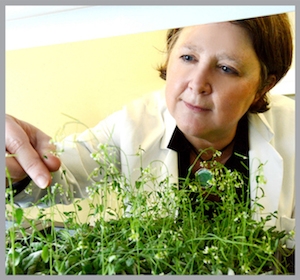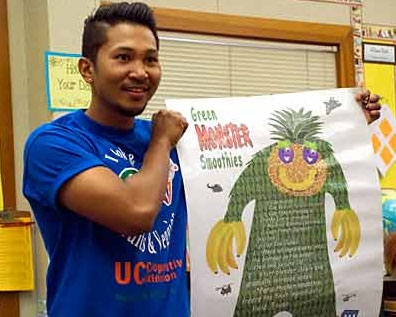UC Food and Agriculture Blogs
UC creates recipes for healthier diets
University of California Cooperative Extension nutrition educator Marc Sanchez brings the fearsome beast with him on school visits to classrooms in Merced and Stanislaus counties.
“Let me introduce to you the Green Monster,” Sanchez says to a classroom of second-graders at Yamato Colony Elementary School in Livingston. “Is anybody scared?”
“Noooo,” the kids roar in defiance of the beast.
The school visits are just one of the ways UC researchers, educators and cooperative extension representatives across the state are encouraging children and their families to eat healthier. They also are introducing them to fresh produce, doing cooking demonstrations and helping school districts prepare healthier meals.
About 17 percent of American children and adolescents are obese, according to the Centers for Disease Control and Prevention. During the last 30 years, obesity rates have more than doubled for children ages 6 to 11 and tripled for adolescents ages 12 to 19. It's an ominous statistic that could be improved if children ate more fruits and veggies.
Connecting schoolkids to farmers
UC's nutrition education programs try to promote better eating habits by connecting schools to local farms and farmers. Known as farm-to-school programs, students learn about where their food comes from and how it's grown — and in the process, learn to eat a balanced diet. Often, the children then become the conduit that brings healthier eating to the whole family.
“UC is on the forefront of these programs,” said Theresa Spezzano, UC Cooperative Extension director for Stanislaus and Merced counties and a nutrition, family and consumer science adviser. “The majority of the work is in some sort of school-based program.”
Nutrition education from UC reaches children, families and classrooms in nearly every part of the state.
Cooperative Extension, part of UC's Division of Agriculture and Natural Resources, runs two federal programs for low-income families in California — the Expanded Food and Nutrition Education Program and the CalFresh Nutrition Education Program. Together they reach more than 180,000 people.
Changing the corner store
At UCLA, public health professor Alex Ortega leads an effort to make more healthy food available in low-income urban areas by working with neighborhood convenience stores to replace junk food with fresh fruits and vegetables.
The project is based in East Los Angeles — a predominately Mexican-American community where diabetes and obesity rates are high. Four stores have agreed to restock their shelves and refrigerators. In return, storeowners are being trained in how to market fresh fruits and vegetables. There is also an outreach program that uses local high school students to educate nearby residents about healthy eating and what's available at the transformed markets.
“It's just one part of a very complex puzzle. We understand other things have to be going on, including promoting more physical activity,” said Ortega, director of the UCLA Center for Population Health and Health Disparities that is funded by the National Heart, Lung and Blood Institute. “Providing access to healthy food is significant part of the puzzle. If people don't have access and health education, you can't expect the community to be eating healthy.”
Ortega said data are being gathered on the effectiveness of the five-year project in East Los Angeles. But even if they don't find extensive shifts in behavior, “just getting people in the community thinking about eating healthier is a major step,” he said.
Education + access = healthy choices
Although there have been few long-term studies on the effectiveness of nutrition education programs, one small study of four schools in Sacramento and Stanislaus counties suggests that farm-to-school education and access to healthier food can help lower obesity rates among children.
The schools are taking part in a UC Davis and Cooperative Extension program called Shaping Healthy Choices, which includes an exercise component, along with nutrition education and access to more fresh produce.
That kind of multi-component program is “a promising model for how schools can play a role in promoting healthy food choices and reducing childhood obesity,” said Sheri Zidenberg-Cherr, co-director of the Center for Nutrition in Schools at UC Davis, who helped lead the study.
In Sanchez's experience, the best way to reach kids is to make eating healthy food a positive experience and one they are likely to remember.
“I can tell them, ‘eat this because it's better for you,' but they hear that all the time,” he said. “I want to do something that catches their eye. What's more appealing, calling it a Green Monster or a spinach drink?”
View a slide show below to experience Marc Sanchez' interaction with children as he teaches healthful eating:
Cooking Video: Massaged Kale Salad
Check out our first video cooking demonstration and learn how to make Massaged Kale Salad: https://www.youtube.com/watch?v=6-OpBPQ36GQ
Oils: Important Garden Pesticides
[From March 2014 issue of the Retail Nursery and Garden Center IPM News.] Oils are often the best pesticide choice for controlling soft-bodied insects and mites, as well as several foliar diseases including powdery mildew in the garden and landscape...
Hail to Hilgard
UC Berkeley has Hilgard Hall. UC Davis has Hilgard Lane. UCLA has Hilgard Avenue. There's even a mineral named hilgardite.
Why is the name Hilgard held in such high regard? Eugene W. Hilgard played a pivotal role in the development of California agriculture, from analyzing the Central Valley's potential as fertile farmland to promoting quality in the state's burgeoning wine industry.
Born in 1833 in Germany, Hilgard is considered the father of modern soil science in the United States. After stints at the University of Mississippi and University of Michigan, in 1875 Hilgard came to UC Berkeley as dean of the College of Agriculture and served as founding director of UC's Agricultural Experiment Station.
Hilgard began his 30-year UC career as a one-man operation, visiting farms throughout the state, inviting growers to send him their questions and answering their letters personally. He helped to inventory the state's diverse soils and taught farmers to better understand them. Under his supervision, soil maps were produced for the first time for many California counties. His research helped show how to remove salts from the alkali soils in the Central Valley, turning what was once barren land into one of the world's most productive farming regions.
With California agriculture now a $45 billion industry and Cooperative Extension celebrating its centennial, it's a good time to toast someone who helped lay the foundation for that success: Eugene Hilgard.
Protecting food crops from powdery mildew
It looks harmless enough – a light dusting like baby powder sprinkled on the leaves. But powdery mildew can attack new buds and shoots, stunt growth and distort plant development. If not controlled, the fast spreading fungus can cause billions of dollars of crop damage in California. For example, powdery mildew is the most significant disease affecting grapes in California, with all productive acreage treated to help minimize loss. Borne by the wind, its spores race through fields and can easily damage a season's crop, resulting in losses of 30 percent or more.
Growers combat powdery mildew with sulfur, fungicides, and other deterrents, but treatment is costly, and timing is difficult. But a much more precise strategy may be on the way.

With the funding from UC Berkeley's Bakar Fellows Program, which supports early-career faculty conducting commercially promising research, Wildermuth is applying her discoveries to protect commercially valuable crops. She uses a plant in the mustard family popular with researchers for it small, sequenced gene and a short life cycle.
“We've already identified the parallel genes in a number of important crops,” she said. “By targeted breeding to limit these genes' powdery mildew-promoting effects, we should be able to protect plants without extensive chemical treatments.”
When powdery mildew spores land on a leaf, the spore germinates and bores through the leaf surface to make a lobe-shaped feeding structure. The fungus also influences nearby plant cells, manipulating the leaf cell physiology to gain nutrients. A high nutrient supply is needed to support the large fungal network on the leaf surface and the formation of new spores, which propagate the infection.
Wildermuth's lab used a highly refined technique under an optical microscope to scrutinize the fungus-plant interaction and focus in on the plant cell housing the fungal feeding structure and the neighboring leaf cells.
"We can see these cells under the microscope and use the laser to cut them out. The dissected cells literally drop into a tube below," she said. "It's quite fun to do."
The research team isolated the cells and extracted the RNA. They then determined which genes are turned on and which are turned off in specific cells at the infection site versus uninfected cells. They zeroed in on genes likely to be critical to the infection process, and used plants in which these genes were knocked out in order to see if the plants respond differently to powdery mildew.
The lab identified a set of genes that actually help the mildew fungus steal more food from the plant. The process, called endo-reduplication, allows cells in the leaf to increase production of DNA without dividing – one of the few ways cells can increase their metabolism and size, Wildermuth says.
“The fungus induces endo-reduplication in the plant cells underneath the feeding structure, and gains access to more nutrients in the leaf.” This, in turn, spurs fungal growth and reproduction. “We showed that if the DNA-enhancing process is blocked, the fungus gets put on a diet, and its proliferation is limited,” she says.
The Bakar Fellowship supports her current effort to determine whether similar genes in grapes, tomatoes and other crops threatened by powdery mildew can be targeted to limit the fungus's growth. Crop strains in which these genes are less active or even absent could be selectively bred to thwart fungal growth.





